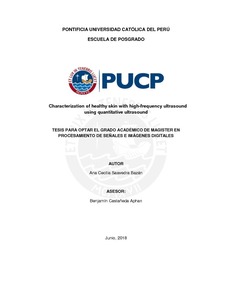| dc.contributor.advisor | Castañeda Aphan, Benjamín | |
| dc.contributor.author | Saavedra Bazán, Ana Cecilia | es_ES |
| dc.date.accessioned | 2018-08-20T21:06:14Z | es_ES |
| dc.date.available | 2018-08-20T21:06:14Z | es_ES |
| dc.date.created | 2018 | es_ES |
| dc.date.issued | 2018-08-20 | es_ES |
| dc.identifier.uri | http://hdl.handle.net/20.500.12404/12471 | |
| dc.description.abstract | The skin is the largest organ of the body that protects it from the external environment. High- frequency ultra sound (HF-US) has been used to visualize the skin in depth and to diagnose some pathologies in dermatological applications. Quantitative ultrasound (QUS) includes several techniques that provide values of particular physical properties. In this thesis work, three QUS parameters are explained and used to characterize healthy skin through HF-US: attenuation coefficient slope (ACS), backscatter coefficient (BSC) and shear wave speed (SWS). They were estimated with the regularized spectral-log difference (RSLD) method, the reference phan- tom method, and the crawling wave sonoelastography method, respectively. All the three parameters were assessed in phantoms, ex vivo and in vivo skin. In calibrated phantoms, RSLD showed a reduc- tion of up to 93% of the standard deviation concerning the estimation with SLD, and BSC showed an agreement with the Faran’s theoretical curve. In gelatin-based phantoms, surface acoustic waves (SAWs) were estimated in two interfaces: solid-water and solid-US gel, which all owed corroborating SAWs presence and finding an empirical compensation factor when the coupling interface is US gel. A correction factor of 0:97 for SAW-to-shear was found to avoid underestimation in phantoms. Porcine thigh was calculated in the range from 8 to 27 MHz, where the ACS was 4:08 _+_0:43 dB cm -1 MHz-1 and BSC was in the range from 10 1 to 10° sr-1 _cm-1. Crawling wave sonoelastography method was applied for the vibration frequencies between 200 Hz and 800 Hz, where SWS was in the range from 4:6 m/sto9:1 m/s. In vivo ACS and BSC were assessed in the healthy forearm and thigh, whereas SWS only in the thigh. The average ACS in the forearm dermis was 2.07dB cm-1 _MHz-1, which is in close agreement with the literature. A significant difference (p < 0.05) was found between the ACS in the forearm dermis and the thigh dermis (average ACS of 2.54dB cm-1 _MHz-1). The BSC of the forearm and thigh dermis were in the range from 10 -1 to 10° sr-1 _cm-1, and in the range from 10-1 to 10° sr-1 _cm-1, respectively. The SWS in the thigh dermis was 2:4 _+_0:38 m/s for a vibration frequency of 200Hz, with an increasing trend as frequency increases. Results suggest that these QUS parameters have the potential to be used as a tool for in vivo skin characterization and show potential for future application in skin lesions. | es_ES |
| dc.description.uri | Tesis | es_ES |
| dc.language.iso | eng | es_ES |
| dc.publisher | Pontificia Universidad Católica del Perú | es_ES |
| dc.rights | info:eu-repo/semantics/closedAccess | es_ES |
| dc.subject | Procesamiento de imágenes digitales | es_ES |
| dc.subject | Ultrasonido en medicina | es_ES |
| dc.subject | Piel--Enfermedades--Diagnóstico por imágenes. | es_ES |
| dc.title | Characterization of healthy skin with high-frequency ultrasound using quantitative ultrasound | es_ES |
| dc.type | info:eu-repo/semantics/masterThesis | es_ES |
| thesis.degree.name | Maestro en Procesamiento de Señales e Imágenes Digitales | es_ES |
| thesis.degree.level | Maestría | es_ES |
| thesis.degree.grantor | Pontificia Universidad Católica del Perú. Escuela de Posgrado | es_ES |
| thesis.degree.discipline | Procesamiento de Señales e Imágenes Digitales | es_ES |
| renati.advisor.dni | 10791304 | |
| renati.discipline | 613077 | es_ES |
| renati.level | https://purl.org/pe-repo/renati/level#maestro | es_ES |
| renati.type | http://purl.org/pe-repo/renati/type#tesis | es_ES |
| dc.publisher.country | PE | es_ES |
| dc.subject.ocde | https://purl.org/pe-repo/ocde/ford#2.02.05 | es_ES |





